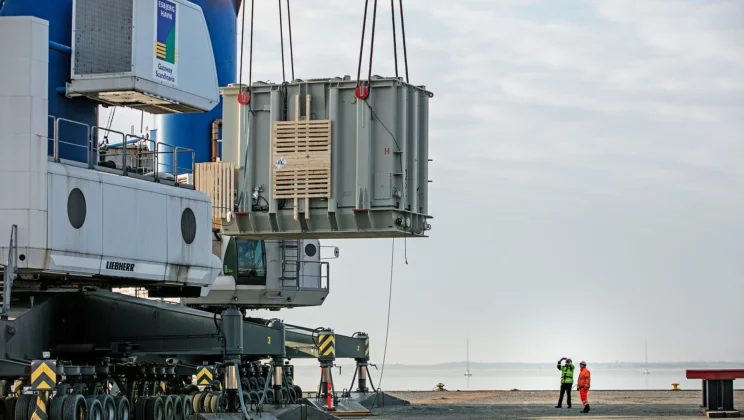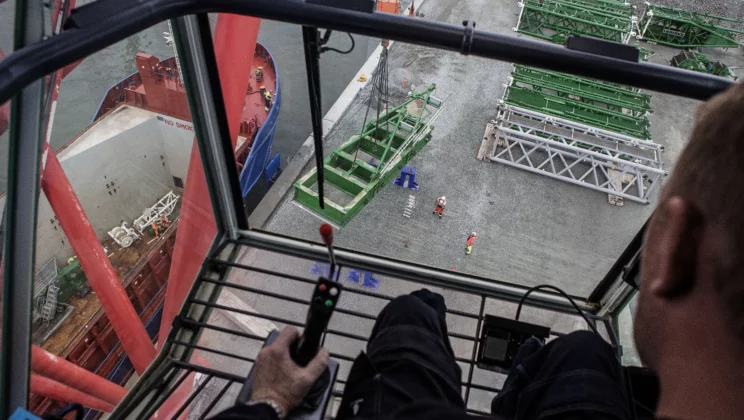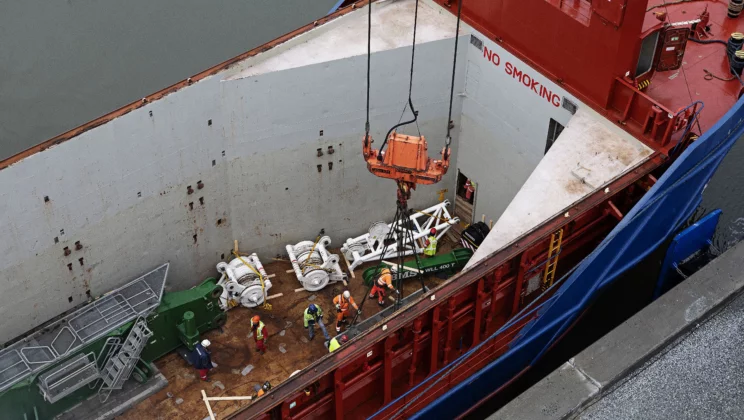No port without cranes. The huge machines and their drivers are an indispensable part of the infrastructure at the Port of Esbjerg. The cranes at the Port of Esbjerg are Scandinavia's largest collection of mobile Liebherr cranes, and in just four years, the number of tasks has increased by 66 percent.
There is a wonderful tranquillity in the cabin of the Liebherr LHM 500. A bit of west wind noise, a lorry revving up far away, but other than that, the silence is wonderful.
We are 25 metres above the ground in a crane weighing 452 tonnes. It is 70 metres tall to the boom tip, and the hook in front of us can carry 150 tonnes in the steel wires. There are enormous forces at play, and that is why silence isn't what you'd expect.
The machine gives off a slight howl when the joystick is moved and the boom moves back or forth or right or left. But no louder than a distant church bell.
There is also a feeling of weightlessness, which is surprising when one takes into account that the crane weighs the same as a fully-laden jumbo jet.
John Fritsen is the team leader and responsible for the crane. A former crane operator turned mechanic, he has even helped assemble one of the smaller cranes at the port, which arrived in kit form.
"The cranes are a natural part of the Port, and many hardly notice them. But the cranes make up an important infrastructure. Freight over the wharf. Without cranes, no wind turbines. That's right: without cranes, no port," he says.
Things are going well for the Port of Esbjerg Port – and the cranes. Between 2013 and 2017 alone, the number of tasks for the quiet giants at the Port of Esbjerg went up by 66 percent.
Watch this animation to learn more about what the Liebherr LHM 500 at the Port of Esbjerg can do.
Flexibility is required
Customers such as Blue Water and Jutlandia Terminal books cranes via e-mail. The order is entered digitally, and the ships are loaded and unloaded after the plan based on when the orders tick in. Otherwise the ships may compete with one another to arrive first and be unloaded before the others.
Six men permanently work on the cranes, and they operate around the clock, if needed. This is often the case. Containers, nacelles, rotor blades and general cargo arrive in a steady stream. Cranes also help when installation vessels require changes in the deck setup and therefore must be rigged.
Double lift at 235 tonnes
The cranes at the port can perform Scandinavia's largest double lift at 235 tonnes. This is, for instance, necessary when a boat needs to be lifted out of the water, as is the case today. Sea Comfort, a crew boat, has broken a screw and needs to be put up on the quay.
During a double lift, a crane operator controls both cranes from one cabin and controls the total lift using cables. It requires a skilled and experienced crane operator to know exactly what happens when you pull one handle on one crane, but not the other.
It takes about 15 minutes to get 135-tonne boat out of the water and onto the pads on the quay. One man controls the cranes.
"It 's pretty complicated, but we are doing it more and more often, and the fact that we love our work makes it even easier," John Fritsen says.
The difficult double lift is also carried out more and more often. From 2013 to 2017, the number of heavy lifts at the port no less than tripled.
Back in the cabin of the Liebherr LHM 500, 25 metres above the ground, the 4-tonne hook swings dangerously in front of the window pane. The writer of this article was allowed to pull the joystick and did so a bit too quickly. On the ground, far below us, a man looks up rather nervously.
But the cranes are very stable.
When the legs are extended, the cranes can work in wind conditions up to 30 metres per second. According to the DMI's index, that equals a 'heavy storm'. A security group at the port can be summoned at short notice and check the security is in order.

The cranes at the port can perform a double lift at 235 tonnes.
Only the job as a fighter pilot is more stressful
The cranes can operate anywhere at the Port, and the 80 wheels can move the cranes around in a short time.
When a task needs to be performed, there is a lot of pressure on the crane operator. It takes a steady hand to lower a set of wind turbine blades weighing 80 tonnes onto a spot and hit the mark with a precision of 1 centimetre. Pulling too hard on the joystick could kill people on the ground and damage the cargo.
There are actually two joysticks and eight buttons that control the crane. When performing a complex lift, there is a lot to keep track of.
"Either you can or you'll never learn it," says crane operator Carsten Sandbæk.
15 years after his first ride in a crane, Carsten's heart rate still rises when a pipe weighing 100 tonnes is dangling right outside the cabin.
"It's not something you to want to invite inside," he says dryly.
Not everyone can cope with the pressure. The list of people who have climbed down from the cabin and never come back, is long. When people are walking under a turbine blade, and it must be placed with an accuracy of 1 centimetre, there is a mental pressure.
"It requires an extreme focus to perform such tasks," Carsten Sandbæk says. According to a US study that Carsten has seen, being a crane operator is the second most stressful job next to being a fighter pilot. There is a constant pressure.
It also requires experience. A colleague on the team has operated the crane for several years, but is 'still under training'.
It does not change the fact that Carsten loves his job.
"These cranes are amazing cranes," he says, gazing almost lovingly up at the 70-metre tall crane. And he doesn't mind that an 8-hour work day feels like driving a car non-stop. Times two. So he is knackered when he gets home.
For Jesper Bank, CCO of the Port, the cranes are a good reflection of the growth of the port in recent years, which have also seen increased requirements for the tasks.
"Project lifts has become a daily business for us. Not least because of the large components of the wind turbine manufacturers, which are loaded and unloaded at the port each day," he says.
Jesper Bank believes that customers at the port measure the completion of the tasks in terms of time, quality and safety.
"Together, our crane operators have an immense amount of experience, and our customers benefit from this. We see extremely few freight damages, unusually few injuries and hardware damages and we get the tasks solved quickly, so that the ship can sail on to the next port."
Back in the cabin, the 4-tonne hook hangs still. A few movements of the boom have stabilised it. Carstens walkie-talkie hisses, and blurts out some incomprehensible tech lingo. Another lift task is waiting.

The view from the cabin of Liebherr LHM 500, 25 metres above the ground.

"It requires an extreme focus to perform such tasks," crane operator Carsten Sandbæk says.
Go to overview

